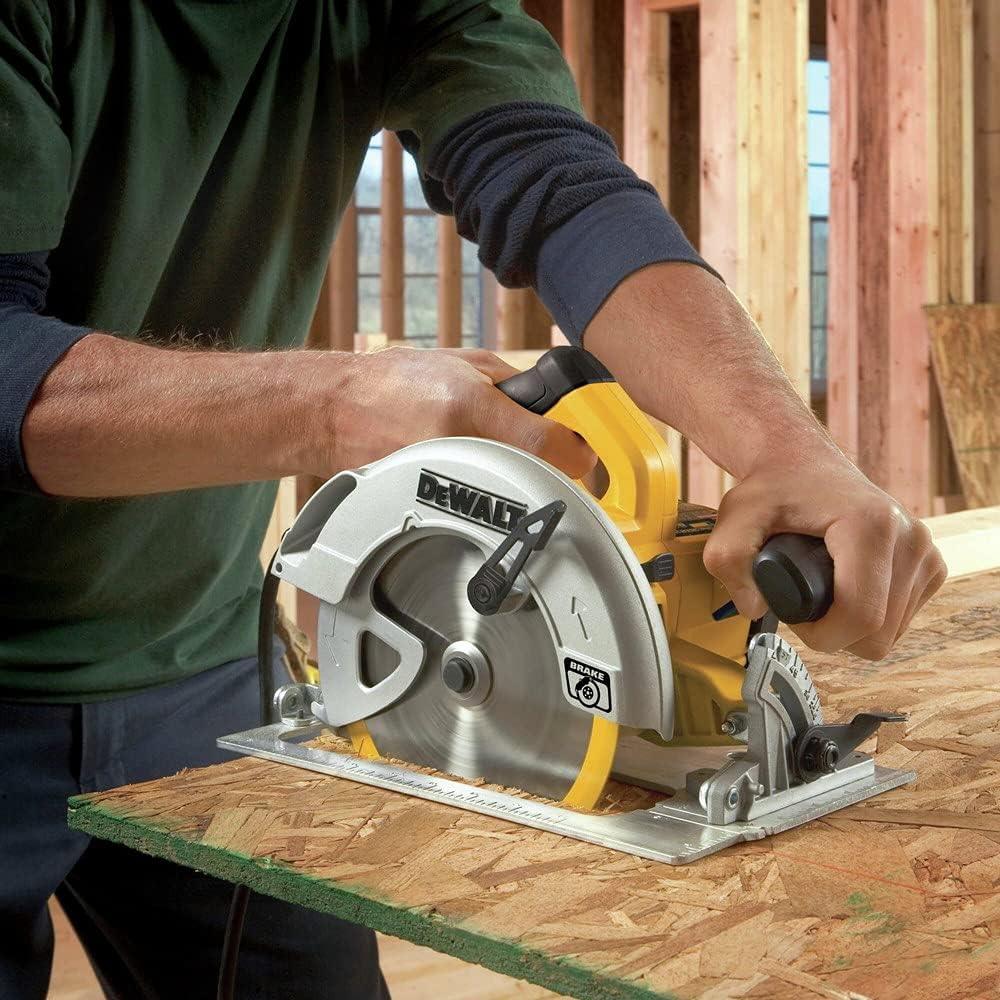A DeWalt cordless circular saw is a powerful and portable cutting tool that brings convenience, efficiency, and versatility to your woodworking and DIY projects. Whether you’re cutting lumber for framing, slicing through plywood for cabinetry, or trimming deck boards, a DeWalt circular saw can handle it all.
If you’re new to using a circular saw, especially a cordless model, you might feel unsure about the setup, operation, or safety. This detailed guide will help you master your DeWalt circular saw—from the first time you pick it up to creating accurate, professional-looking cuts.
Let’s get started!
🔨 What is a DeWalt Cordless Circular Saw?
A circular saw uses a round, toothed blade spinning at high speed to cut through wood, metal, and plastic. Unlike corded models, DeWalt cordless circular saws use rechargeable lithium-ion batteries (usually 20V MAX or FLEXVOLT 60V MAX), making them portable and easy to use anywhere without a power outlet.
Popular DeWalt circular saw models include:
- DeWalt DCS570 7-1/4″ 20V MAX – Great for standard wood cuts with ample power.
- DeWalt DCS391 6-1/2″ 20V MAX – Compact and lightweight for quick jobs.
- DeWalt DCS578 FLEXVOLT 60V MAX – Heavy-duty cutting power with extended runtime.
👷 Essential Safety Precautions
Before using a circular saw, remember: safety comes first. Here’s what you must do:
✅ Wear Personal Protective Equipment (PPE) – Safety glasses, hearing protection, dust mask, gloves, and work boots.
✅ Inspect the Saw and Blade – Look for cracks, missing teeth, or damage. Ensure the blade guard moves freely and the battery is charged.
✅ Clear Your Work Area – Remove any clutter or obstacles from your cutting space.
✅ Use Stable Support – Workpieces should be secured on sawhorses or a sturdy workbench. Never cut unsupported material.
✅ Keep Both Hands on the Saw – One hand on the main handle, one on the auxiliary handle for stability.
✅ Stand to the Side of the Cut Line – Avoid standing directly behind the saw to reduce kickback risks.
✅ Unplug (or Remove Battery) Before Adjusting – Always disconnect power before blade changes or adjustments.

🪚 Parts of a DeWalt Circular Saw
Familiarize yourself with key components:
- Blade Guard – Covers the blade for safety; retracts during cuts.
- Shoe (Base Plate) – Rests flat on the material for stability.
- Bevel Adjustment – Allows angled cuts, up to 45 degrees.
- Depth Adjustment – Controls how deep the blade cuts into material.
- Trigger and Safety Lock – Controls saw power and prevents accidental starts.
- Battery Slot – Where the battery pack connects for power.
🔋 Inserting the Battery
1️⃣ Slide a fully charged DeWalt lithium-ion battery into the saw’s slot until it clicks.
2️⃣ Make sure the battery is secure.
3️⃣ If your saw has a battery level indicator, check the charge before starting.
🔎 Pro Tip: Keep a spare charged battery on hand for uninterrupted work, especially for large projects.
⚙️ Blade Selection and Installation
Choosing the right blade for your project is crucial:
- Framing Blade (24-tooth) – Fast, rough cuts in framing lumber.
- Finish Blade (40-60 tooth) – Smooth cuts for trim, plywood, and fine woodworking.
- Metal-Cutting Blade – Specially designed for thin metal and aluminum.
🔩 To Install a Blade:
- Remove the battery.
- Use the blade wrench (usually stored on the saw) to loosen the arbor bolt.
- Remove the old blade, noting its orientation.
- Insert the new blade with teeth facing forward (follow the arrow on the guard).
- Tighten the arbor bolt securely.
- Replace the battery.
📏 Setting Cutting Depth and Bevel
Adjusting Cutting Depth:
- Locate the depth adjustment lever or knob.
- Set the blade to cut 1/4 inch deeper than your material thickness.
- Lock the adjustment securely.
🔎 Why? A correct blade depth reduces resistance, improves accuracy, and minimizes kickback.
Adjusting Bevel Angle:
- Locate the bevel adjustment lever.
- Tilt the shoe to your desired angle (0–45°).
- Tighten the lever securely.
✏️ Marking the Cut Line
- Use a measuring tape, square, and pencil to mark the cut.
- For long cuts, use a chalk line or clamp a straightedge guide.
- Always mark the side to keep, and cut along the waste side of the line.
🏗️ Making the Cut: Step-by-Step
1️⃣ Position the Material – Secure it on sawhorses or a workbench with clamps.
2️⃣ Align the Saw – Place the shoe’s front edge on the workpiece, blade clear of the material.
3️⃣ Check the Blade Path – Align the blade with your marked line using the guide notch.
4️⃣ Start the Saw – Press the safety lock (if equipped) and squeeze the trigger. Let the blade reach full speed.
5️⃣ Cut with Steady Pressure – Push the saw forward steadily, keeping it flat on the work surface. Don’t force the cut; let the blade do the work.
6️⃣ Complete the Cut – Continue until the blade fully clears the material.
7️⃣ Release the Trigger – Let the blade stop spinning completely before setting the saw down.
💡 Pro Tips for Clean and Accurate Cuts
🔸 Use a Rip Guide or Straightedge – Clamp a guide along the cut line for perfectly straight cuts.
🔸 Score with a Utility Knife – For plywood, scoring helps prevent splintering.
🔸 Cut with Good Side Down – DeWalt saws cut upward; place the project’s good side down.
🔸 Support Both Sides – Especially for long boards or sheets, prevent pinching or tearing.
🔸 Keep Hands Clear – Always keep hands at a safe distance from the blade path.
🚫 Common Mistakes to Avoid
❌ Forcing the Saw – Pushing too hard can bind the blade or cause rough cuts.
❌ Wrong Blade for the Job – Use a blade matched to your material and project.
❌ Inadequate Support – Unstable material can pinch the blade, causing kickback.
❌ Skipping Safety Gear – Always wear PPE, no matter how quick the cut.
❌ Setting Blade Too Deep – Excessive blade depth increases resistance and risk.
🛠️ Maintaining Your DeWalt Circular Saw
- Clean the Blade and Housing – Remove debris after use to prevent buildup.
- Check Battery Contacts – Keep them clean and dry.
- Inspect Moving Parts – Test the blade guard and adjustment levers for smooth movement.
- Replace Worn Blades – Dull blades make cuts harder and less accurate.
- Store Safely – Keep your saw in a dry place, ideally in a case or cabinet.
🏆 Practice Projects for Beginners
Once you’re comfortable, try these beginner-friendly projects:
- Simple Bookshelf or Storage Rack – Learn crosscuts and rip cuts on lumber.
- DIY Plywood Workshop Table – Practice cutting sheet materials.
- Garden Planter Box – Combine angle cuts and straight cuts.
- Rustic Wooden Sign – Use precise cuts for decorative projects.
🚀 Conclusion: Mastering Your DeWalt Cordless Circular Saw
A DeWalt cordless circular saw isn’t just a power tool—it’s a gateway to countless DIY projects, woodworking endeavors, and home improvements. By understanding its components, prioritizing safety, practicing precise cuts, and maintaining your saw, you’ll quickly gain confidence and skill.
Take your time. Start with simple cuts, master your technique, and soon, you’ll be handling complex projects with ease and precision.

